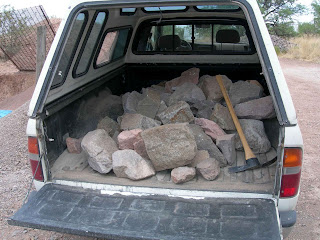Stone Driveway
Construction of this stone ramp was essential to provide all-season access to desert homestead.
1.8.05
31.7.05
Necessity for Access
 This picture was taken in the rainy season (July/August) in Arivaca, Arizona and shows my driveway leading down to a dry wash.
This picture was taken in the rainy season (July/August) in Arivaca, Arizona and shows my driveway leading down to a dry wash.The incline (foreground) is a lot steeper than the photo shows. The soil is clay which becomes muck when wet and the ruts were becoming deeper.
Delivery trucks were complaining and passenger cars were struggling up the incline on the way out.
I needed a robust solution, but wanted a 'natural' look to compliment the landscape as opposed to a stirle concrete ramp. I decided that stone would be the way to go because it is a locally available resource and would look great when completed.
Note: Click on any photos in this blog to enlarge
25.7.05
Raw Material - Stone
 The first step was to collect the stone required for the ramp. Mornings I would head out to nearby mountains and haul stone out of dry washes and old mining sites.
The first step was to collect the stone required for the ramp. Mornings I would head out to nearby mountains and haul stone out of dry washes and old mining sites.For this project, 8-tons of rock was used.
I beat the heck out of my 4-cylinder 2-wheel drive Toyota Tacoma; loading in a ton of stone day-after-day. The leaf springs are now pernamently deformed. I added 1-ton air shock lifters on the rear axle to handle the load.
Why don't I just get a bigger truck? 25 MPG - that's why!
21.6.05
Procrastinating Is Over
During the walk to lock my gate at night up this drive, I would think of these 'infrastructure' projects as necessary, but time consuming.
I knew this would be a big job at a time when I really wanted to begin my cob studio (see: http://cobstudio.blogspot.com/).
15.6.05
Roman Road
My friends say I was building a Roman road. Not quite, but now I know how they (slaves) must have felt building it.
I started with stakes and set a string between the top and bottom of the incline. I wanted a ramp as opposed to the natural 'concave' shape that created a steep dip-down, that made it difficult and dangerous when towing trailers with materials.
About mid-way down this ramp where the natural shape of the slope created a dip, rocks were cemented-in about 18" deep.
10.6.05
Completed
Therefore, after finishing the stone ramp, I put attention into grading and adding a gravel base(obtained from dry river beds), to the driveway. The gravel is important to put on top of the clay driveway base. This is important not only to keep tires from getting mucky during summer rains, but over time, the gravel sets into the clay when wet and builds-up a base over time. Gravel needs to be added to the driveway as part of normal maintenance, but I've noticed that this gravel embedding itself deeper in the soil is establishing a firm base that is becoming less and less effected by rain and erosion.
2.6.05
Natural Revegitation
It took a full month to complete this project; but the end result was the natural look I wanted to achieve, without compromising on a 'rock-solid' maintenance-free solution to improved access to my property.
Subscribe to:
Posts (Atom)